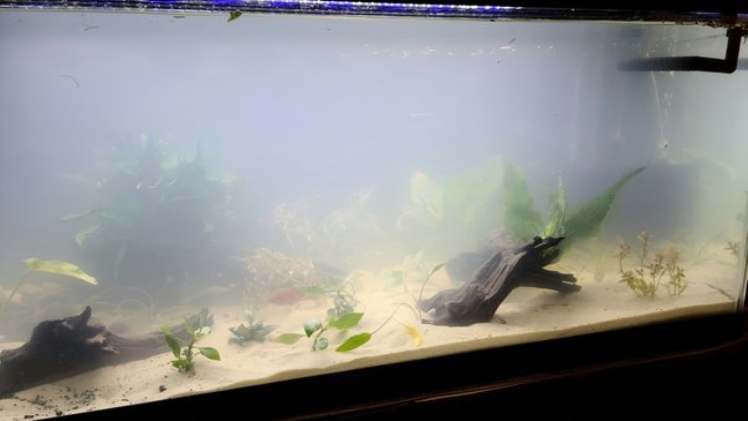An aquarium filled with crystal-clear water is a mesmerizing sight, showcasing the beauty of your aquatic pets and their underwater world. However, sometimes you may encounter the frustrating issue of cloudy water just a day after setting up your fish tank. This cloudiness can result from various factors, including the initial stages of cycling, substrate disturbances, and bacterial blooms. In this article, we will delve into the common causes of cloudy fish tank water after just one day and explore ways to address and prevent this issue.
1. New Tank Syndrome
One of the most common reasons for cloudy water in a newly established fish tank is what’s often referred to as “New Tank Syndrome.” When you first set up an aquarium, it undergoes a natural cycling process to establish the necessary beneficial bacteria that convert toxic ammonia into less harmful substances like nitrites and nitrates. During this cycle, cloudy water is not uncommon, especially in the first few days.
Cause: The cloudiness is typically a result of an initial surge in ammonia levels as uneaten fish food, fish waste, and decaying plant matter break down.
Solution: You can address this by being patient and allowing the tank to naturally cycle. Do not add fish to the aquarium until the cycling process is complete, usually within a few weeks. Regularly testing the water parameters (ammonia, nitrites, and nitrates) will help you monitor the progress.
2. Disturbances in the Substrate
The substrate, which is the material at the bottom of your aquarium, can be another source of cloudy water. This is especially common in tanks with fine sand or freshly added substrate material.
Cause: Disturbances in the substrate, whether from planting or moving decorations, can release fine particles and debris into the water column, leading to cloudiness.
Solution: When adding new substrate or plants, do so gently to minimize disturbance. You can also rinse the substrate thoroughly before adding it to the tank to remove excess particles. Installing a substrate barrier or using substrate supports can help prevent cloudiness due to substrate disturbance.
3. Bacterial Blooms
Bacterial blooms occur when certain types of bacteria multiply rapidly, creating a milky or cloudy appearance in the water.
Cause: These blooms can be triggered by changes in water parameters, such as temperature fluctuations, shifts in pH levels, or the addition of new biological materials to the tank.
Solution: Regular water testing and stable water conditions are key to preventing bacterial blooms. Using a water conditioner can help neutralize chlorine and chloramines in tap water. Be patient, as bacterial blooms usually resolve themselves once the tank stabilizes.
4. Overfeeding and Excess Organic Matter
Excess fish food and organic matter can accumulate in the tank, leading to water cloudiness. Uneaten food and decaying matter contribute to the rise of organic compounds, which can result in poor water quality.
Cause: Overfeeding, allowing uneaten food to accumulate, or not properly maintaining the tank can lead to an increase in organic matter.
Solution: Feed your fish sparingly and remove any uneaten food after a few minutes. Perform regular water changes and clean the substrate to remove excess organic matter. Maintaining a properly functioning filter is also essential to help remove organic debris from the water.
5. Inadequate Filtration
Insufficient filtration can allow particulate matter and waste to accumulate in the water, causing cloudiness.
Cause: Inadequate filtration, including undersized or clogged filters, can lead to poor water circulation and the buildup of debris.
Solution: Ensure your filtration system is appropriately sized for your tank, and regularly clean or replace filter media to maintain its effectiveness. Adequate water circulation is crucial to prevent particles from settling in the tank.
6. Algae Blooms
Algae can thrive in the presence of excess nutrients and light, resulting in cloudy or greenish water.
Cause: Algae blooms can occur when there’s an excess of nutrients, such as nitrate and phosphate, and excessive lighting. Algae can quickly multiply under favorable conditions.
Solution: To prevent or treat algae blooms, maintain proper water quality by conducting regular water changes and monitoring nutrient levels. Adjust the lighting duration and intensity to discourage algae growth. Algae-eating fish and invertebrates can also help keep algae in check.
7. Inadequate Water Conditioning
Failing to use a water conditioner when adding tap water to the aquarium can result in cloudy water.
Cause: Tap water often contains chlorine, chloramines, and heavy metals that can be harmful to your fish and the tank’s ecosystem. Not using a water conditioner can lead to water quality issues.
Solution: Always treat tap water with a water conditioner before adding it to the tank. This will neutralize harmful chemicals and ensure the safety of your fish.
8. Fish Stress and Disease
Fish stress, disease, or injury can sometimes result in a cloudy appearance in the water, as the fish may produce excess mucus or particles during their struggle.
Cause: Various factors, such as poor water quality, overcrowding, aggressive tankmates, or disease, can lead to fish stress and cloudiness.
Solution: Regularly monitor and maintain water quality, provide a suitable environment for your fish, and promptly address any health or aggression issues. Quarantine new fish to prevent the introduction of disease.
Conclusion
Cloudy water in your fish tank after just one day can be attributed to various factors, but it’s crucial to identify the underlying cause and take appropriate steps to address it. Regular maintenance, proper feeding practices, and water testing are essential for keeping your aquarium water clear and your fish healthy. By understanding the common causes and solutions for cloudy water, you can create a thriving aquatic environment for your aquatic pets to enjoy.

